| Author |
Message |
Kirk Lee Spencer

|
 Posted: Tue 23 Nov, 2004 9:28 pm Post subject: Kopis/Falcata Posted: Tue 23 Nov, 2004 9:28 pm Post subject: Kopis/Falcata |
 |
|
With all the recent attention on Alexander the Great, I thought I would start a thread on a very interesting sword… one that the Macedonian general may have used… The Kopis/Falcata! It is believed to be the distant offspring of the Egyptian pole axe which evolved into the Khopesh of Egypt and canaan. Changing into the Kopis in the hands of the Greeks. Kopis from the Greek verb “Kopto” meaning “to cut.” And this is indeed a good name, for the Kopis is clearly designed to cut. It is the ultimate chopping sword. And if it does not have the balance of a sword… If the weight is out at the tip, it must be remembered that it is also an axe… or at least a “missing” link between the axe and the Falchion. The weight is carried toward the tip where it will do the most damage as it drives the cutting edge deep into the target. This is especially true when gravity is added to the driving force in a powerful downward chopping blow. Almost all period depictions of the Kopis in use show this devastating motion (see attachment). The distinctive wrap around grip would help to keep the sword from being pulled out of hand as a result of the outward inertia produced by such a blade-heavy weapon… especially swinging around a large body shield. (I am going from memory here... so if I have mis-spoken, please correct me...)
[This thread was inspired by the landmark work of Fernando Quesada Sanz entitled: “El armamento ibérico: Estudio tipológico,geográfico, funcional, social y simbólico de las armas en la cultura ibérica (siglos VI–I a.C. 2 vols.) As the title suggests F. Quesada Sanz illuminates the typology, geographical distribution, function, social and symbolic aspects of Iberian weapon systems within Iberian culture. It was the material on the Falcata that fascinated me. Because this important work is so difficult to find, I thought I would share a series of montages of some of the graphic information. It is imperative that the reader not attempt to draw any conclusions whatsoever about the historical or forging traditions from the grouping of sword forms in these montages. They are mixtures of forms from many different discussions throughout the work. I have simply grouped them into a condensed form based on similar form to save space. These groupings are not meant to convey any information other than the varieties of design. I encourage anyone who would like to understand the historical and geographical relationships to get access to this landmark work and examine the many fine figures within their context.
And excellent summary and review of the complete work can be found here: http://uam.academia.edu/FernandoQuesadaSanz/Books ]
 Attachment: 78.58 KB Attachment: 78.58 KB
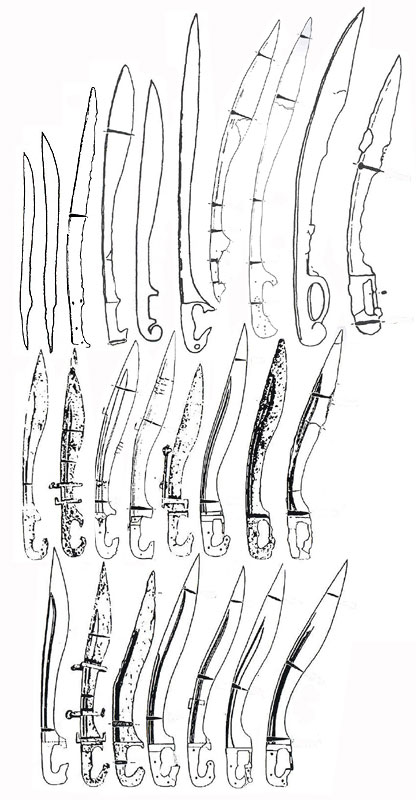
Photoshop Montage of Most of the Falcata Drawings from “El Armamento Iberico” by Fernando Quesada Sanz
 Attachment: 97.79 KB Attachment: 97.79 KB
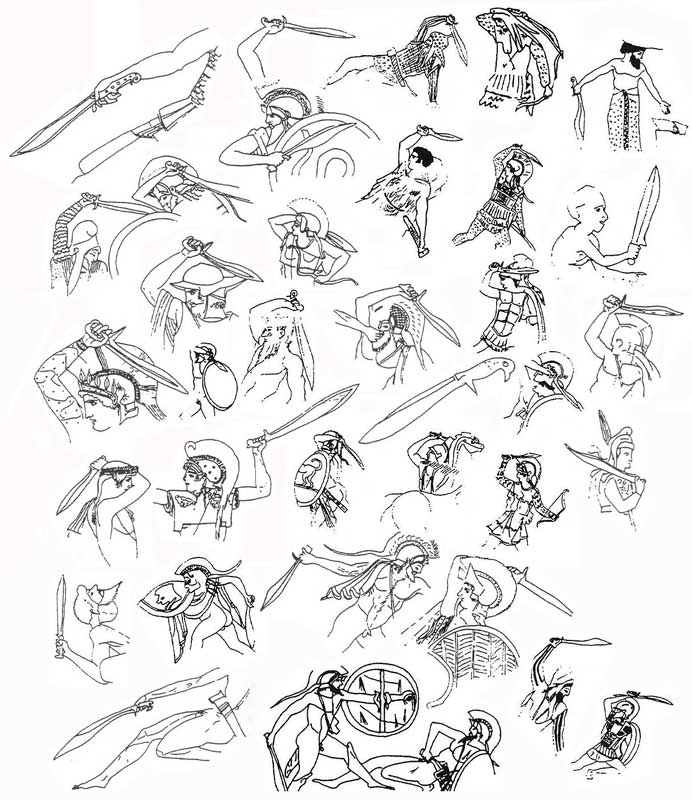
Photoshop Montage of Many Different Period Depictions of the Kopis in Action
 Attachment: 83.55 KB Attachment: 83.55 KB
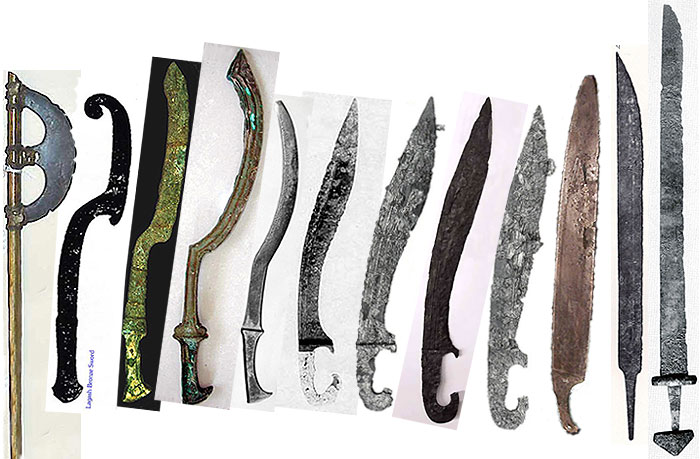
Possible Line of Development From Pole Axe to Khopesh to Kopis to Seax to Viking
Two swords
Lit in Eden’s flame
One of iron and one of ink
To place within a bloody hand
One of God or one of man
Our souls to one of
Two eternities
|
|
  |
 |
Kirk Lee Spencer

|
 Posted: Tue 23 Nov, 2004 9:39 pm Post subject: Posted: Tue 23 Nov, 2004 9:39 pm Post subject: |
 |
|
It is appropriate that Alexander the Great would be associated with the Kopis, for it is believed that he is partly to blame for its popularity and wide distribution. He carried the design into Turkey where it still survives as the Yataghan and even into India where it can still be seen in the Nepalese Kukri and Kora. And, as the Hellenistic empires carried the Kopis into Spain it became known as the Falcata. It is in the in the hands of the Carthaginians that the Romans first encounter this Iberian helmet breaker. If you image a straight sword with a forward recurve edge on both sides you would not be far from the Gladius Hispanicus… It is a double-edged Falcata of sorts. It is possible that this is the precursor to the Roman gladius… especially as seen in the Mainz pattern.
ks
 Attachment: 71.24 KB Attachment: 71.24 KB
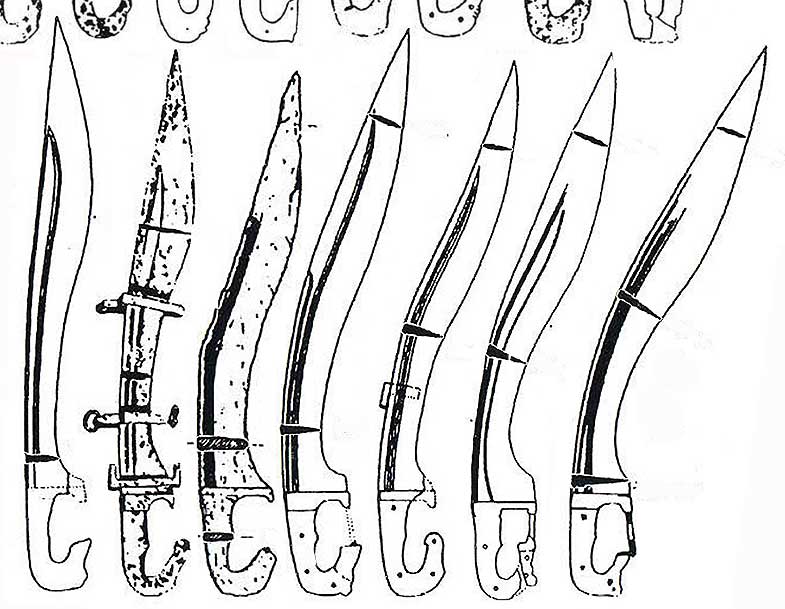
From “El Armamento Iberico” by Fernando Quesada Sanz
 Attachment: 78.32 KB Attachment: 78.32 KB
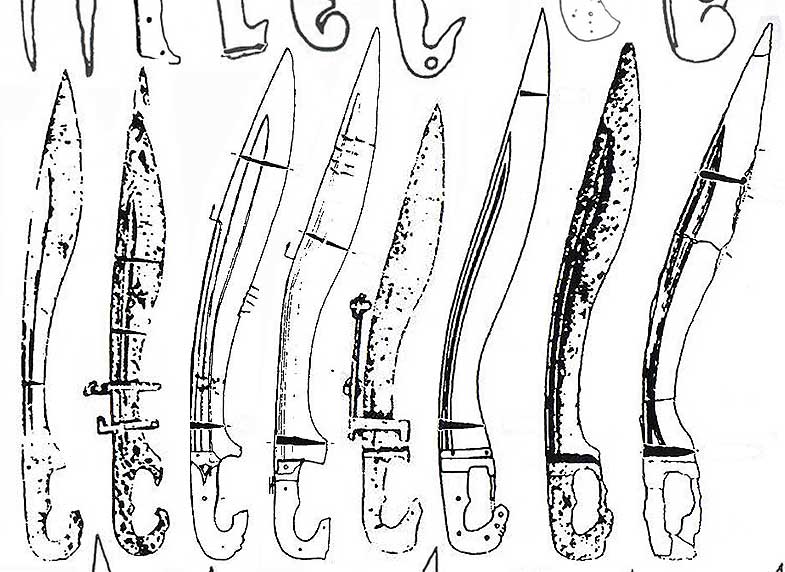
From “El Armamento Iberico” by Fernando Quesada Sanz
 Attachment: 89.79 KB Attachment: 89.79 KB

From “El Armamento Iberico” by Fernando Quesada Sanz
Two swords
Lit in Eden’s flame
One of iron and one of ink
To place within a bloody hand
One of God or one of man
Our souls to one of
Two eternities
|
|
  |
 |
Kirk Lee Spencer

|
 Posted: Tue 23 Nov, 2004 9:49 pm Post subject: Posted: Tue 23 Nov, 2004 9:49 pm Post subject: |
 |
|
Here are some more of the technical drawings in “El Armamento Iberico” by Fernando Quesada Sanz....
ks
 Attachment: 94.31 KB Attachment: 94.31 KB

More Forte Drawings
 Attachment: 88.87 KB Attachment: 88.87 KB

Forte Drawings
 Attachment: 88.84 KB Attachment: 88.84 KB
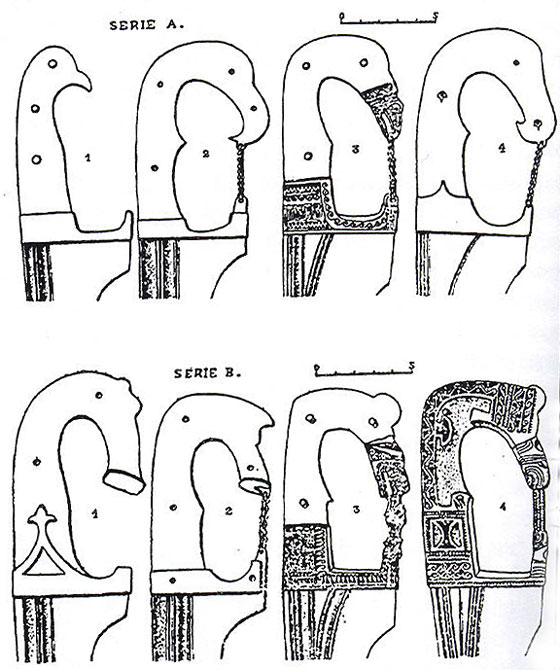
Bird and Horse Head Grip Drawings
Two swords
Lit in Eden’s flame
One of iron and one of ink
To place within a bloody hand
One of God or one of man
Our souls to one of
Two eternities
|
|
  |
 |
Kirk Lee Spencer

|
 Posted: Tue 23 Nov, 2004 9:58 pm Post subject: Posted: Tue 23 Nov, 2004 9:58 pm Post subject: |
 |
|
Lastly... a couple of close up pics showing some nice inlay work and some blade sections showing fullering patterns.
ks
 Attachment: 89.9 KB Attachment: 89.9 KB
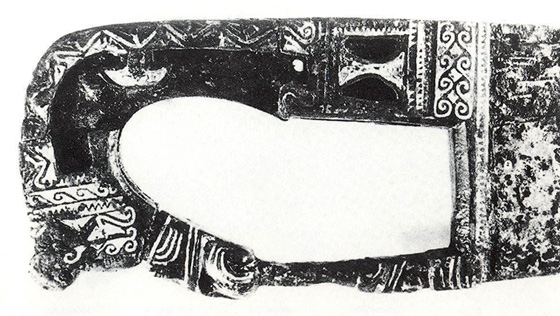
From “El Armamento Iberico” by Fernando Quesada Sanz
 Attachment: 97.39 KB Attachment: 97.39 KB
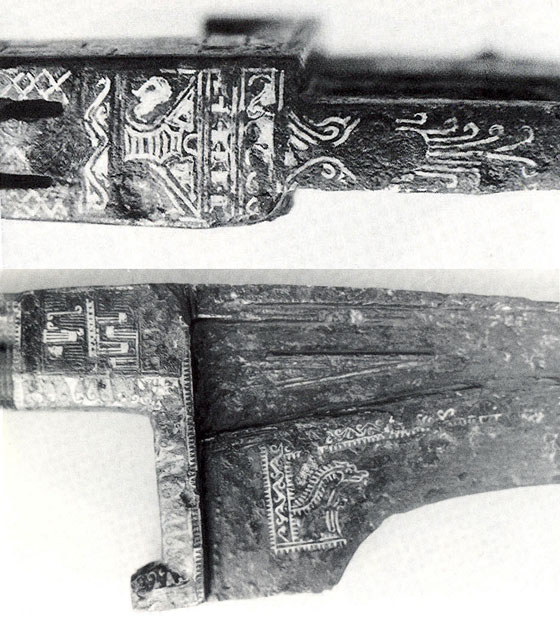
From “El Armamento Iberico” by Fernando Quesada Sanz
 Attachment: 46.96 KB Attachment: 46.96 KB

From “El Armamento Iberico” by Fernando Quesada Sanz
Two swords
Lit in Eden’s flame
One of iron and one of ink
To place within a bloody hand
One of God or one of man
Our souls to one of
Two eternities
Last edited by Kirk Lee Spencer on Tue 23 Nov, 2004 10:41 pm; edited 1 time in total
|
|
  |
 |
Bill Grandy
myArmoury Team


|
 Posted: Tue 23 Nov, 2004 10:02 pm Post subject: Posted: Tue 23 Nov, 2004 10:02 pm Post subject: |
 |
|
|
Thanks for the awesome pics, Kirk! I never knew about Alexander's role in making the kopis popular.
|
|
   |
 |
|
Douglas G.
|
 Posted: Wed 24 Nov, 2004 12:37 am Post subject: Posted: Wed 24 Nov, 2004 12:37 am Post subject: |
 |
|
A Persian friend of mine says we only know of "Alexander" because they
remembered him when Europe had gone dozy after the Fifth Century C.E.
Farhad maintains that even the name by which we know him is proof,
Alexander from Al-Secander, Secander being his proper name. Since there
could be no way all access to works written in Latin and Greek was lost in
this time I have to demure. Still, it's interesting to learn about claims to the
Alexander legacy from deep in Asia Minor.
Best,
Doug G.
|
|
  |
 |
Steve Grisetti

|
 Posted: Wed 24 Nov, 2004 10:54 am Post subject: Alexander's name Posted: Wed 24 Nov, 2004 10:54 am Post subject: Alexander's name |
 |
|
| Douglas G. wrote: | A Persian friend of mine says we only know of "Alexander" because they
remembered him when Europe had gone dozy after the Fifth Century C.E.
Farhad maintains that even the name by which we know him is proof,
Alexander from Al-Secander, Secander being his proper name. Since there
could be no way all access to works written in Latin and Greek was lost in
this time I have to demure. Still, it's interesting to learn about claims to the
Alexander legacy from deep in Asia Minor.
Best,
Doug G. |
For what it is worth, I lived in Egypt some years ago, and the Egyptian city we know as Alexandria is called Iskandariya in Arabic. So, very similar pronunciation. And in Turkey, there is a city called Iskenderun or Alexandretta.
|
|
  |
 |
Nathan Robinson
myArmoury Admin


|
|
    |
 |
|
Patrick Kelly
|
 Posted: Wed 24 Nov, 2004 2:52 pm Post subject: Posted: Wed 24 Nov, 2004 2:52 pm Post subject: |
 |
|
Great information Kirk!
The falcata/kopis has always been a particular favorite of mine so this thread is greatly appreciated.
Did you get these illustrations from a particular book or did you do them yourself?
"In valor there is hope.".................. Tacitus
|
|
   |
 |
Kirk Lee Spencer

|
 Posted: Fri 26 Nov, 2004 11:14 am Post subject: Posted: Fri 26 Nov, 2004 11:14 am Post subject: |
 |
|
| Nathan Robinson wrote: | | Kirk , I've never seen drawings of the cross-sectional properties of the Falcata. Do you happen, by chance, to have any information on the metalurgy or material usage for these weapons? Many of those blade properties are super complex, and I'm starting to become very interested in the constructional aspects related to the making of this sword: both in terms of tooling and methodology. |
Hi Nathan...
Sorry it has taken me so long to respond... I have been at my grandmothers for Thanksgiving and she does not have a computer, much less the internet.
Most all of the illustrations were taken from “El Armamento Iberico” by Fernando Quesada Sanz. It was written in Spanish... and with the tiny amount of Spanish that I know, I did not see any discussion of metallurgy. That would be a very interesting study however, especially considering the Celtic influence and the experimentation going on with the Celtic bladesmiths. When I saw all the different varieties of cross sections and how they change from sword to sword and moving down the blade in the same sword, I could not help but think that these Celto-Iberians may be using the complex sets of chiseled fullers to try and achieve more flexibility in the spine of the blade... Or it could just be decoration I guess 
There is one diagram that seems to suggest that the Iberian Falcata was not a modification of an imported Greek Kopis, but rather a progressive enlarging of the curved Celtic knives into a sword sized weapon. (sort of like the later Seax becoming the Langseax). Here is the diagram...
ks
 Attachment: 61.26 KB Attachment: 61.26 KB
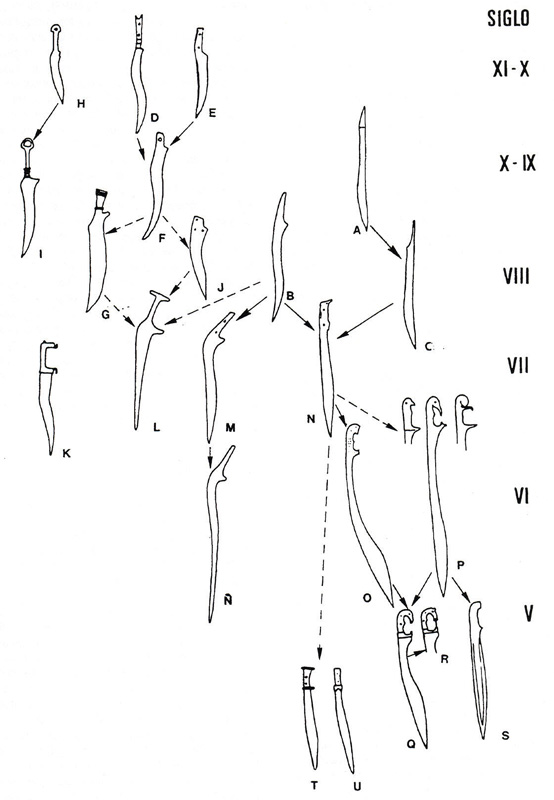
Two swords
Lit in Eden’s flame
One of iron and one of ink
To place within a bloody hand
One of God or one of man
Our souls to one of
Two eternities
|
|
  |
 |
Kirk Lee Spencer

|
 Posted: Fri 26 Nov, 2004 11:24 am Post subject: Posted: Fri 26 Nov, 2004 11:24 am Post subject: |
 |
|
| Patrick Kelly wrote: | Great information Kirk!
The falcata/kopis has always been a particular favorite of mine so this thread is greatly appreciated.
Did you get these illustrations from a particular book or did you do them yourself? |
Hi Patrick...
The first illustration was something I worked up in photoshop from images taken from several sources. All the others are from “El Armamento Iberico” by Fernando Quesada Sanz. However every one (other than the chart of blade cross-sections) were combined from many plates and figures in the original work.
My primary reason for combining them was to see if I can recognize progressions in the blade geometries. It also helps that I can reduce the important subject matter of 20-30 figures and plates into 7 or 8. For instance the compilation of period depictions of the Falcata in use was taken from many figures in the original work and I even through in a few that I have collected from another source.
ks
Two swords
Lit in Eden’s flame
One of iron and one of ink
To place within a bloody hand
One of God or one of man
Our souls to one of
Two eternities
|
|
  |
 |
|
Patrick Kelly
|
 Posted: Fri 26 Nov, 2004 3:33 pm Post subject: Posted: Fri 26 Nov, 2004 3:33 pm Post subject: |
 |
|
| Kirk Lee Spencer wrote: | | Patrick Kelly wrote: | Great information Kirk!
The falcata/kopis has always been a particular favorite of mine so this thread is greatly appreciated.
Did you get these illustrations from a particular book or did you do them yourself? |
Hi Patrick...
The first illustration was something I worked up in photoshop from images taken from several sources. All the others are from “El Armamento Iberico” by Fernando Quesada Sanz. However every one (other than the chart of blade cross-sections) were combined from many plates and figures in the original work.
My primary reason for combining them was to see if I can recognize progressions in the blade geometries. It also helps that I can reduce the important subject matter of 20-30 figures and plates into 7 or 8. For instance the compilation of period depictions of the Falcata in use was taken from many figures in the original work and I even through in a few that I have collected from another source.
ks |
Thanks again Kirk!
The illustrations you put together are outstanding and very educational.
Nathan,
I think Kirk's images might deserve a photo album of their own so that we can keep them as a permanent reference.
"In valor there is hope.".................. Tacitus
|
|
   |
 |
Greyson Brown

|
 Posted: Fri 26 Nov, 2004 4:17 pm Post subject: Posted: Fri 26 Nov, 2004 4:17 pm Post subject: |
 |
|
While it does not belong to my main area of interest, I have always been interested by the falcata, but I have never seen a work that shows that many varieties, or goes to that length to show their evolution. Thank you; these images have been very informative, and I second the idea of finding them a permanent place.
-Grey
|
|
  |
 |
Nathan Robinson
myArmoury Admin


|
|
    |
 |
Nathan Robinson
myArmoury Admin


|
 Posted: Fri 26 Nov, 2004 6:16 pm Post subject: Posted: Fri 26 Nov, 2004 6:16 pm Post subject: |
 |
|
I don't know a whole lot about these swords, so please keep that in mind when reading this question. While I think it's obvious that these types of blades are extremely adept at chopping and cutting, I'm curious about the ability for them in the thrust. It would seem to me that the shape of the blade, like a khukri, would put the tip in a very natural position for an easy thrust. In other words, while the shaping of the blade makes for a more efficient chopper, it would seem to me that it doesn't detract from the thrusting ability. Thoughts?
.:. Visit my Collection Gallery :: View my Reading List :: View my Wish List :: See Pages I Like :: Find me on Facebook .:.
|
|
    |
 |
Jean Thibodeau

|
 Posted: Fri 26 Nov, 2004 8:15 pm Post subject: Posted: Fri 26 Nov, 2004 8:15 pm Post subject: |
 |
|
Nathan;
I have a Coldsteel Khukri and it seems to me that keeping the wrist in a neutral position put the point almost strait forward and that a snap cut would make the point dig into a target.
So although primarely a cutter the use of the point seems very usable.
You can easily give up your freedom. You have to fight hard to get it back!
|
|
  |
 |
Nathan Robinson
myArmoury Admin


|
 Posted: Fri 26 Nov, 2004 8:17 pm Post subject: Posted: Fri 26 Nov, 2004 8:17 pm Post subject: |
 |
|
| Jean Thibodeau wrote: | I have a Coldsteel Khukri and it seems to me that keeping the wrist in a neutral position put the point almost strait forward and that a snap cut would make the point dig into a target.
So although primarely a cutter the use of the point seems very usable. |
That's exactly the kind of feedback I was hoping to hear. (keep it coming!)
.:. Visit my Collection Gallery :: View my Reading List :: View my Wish List :: See Pages I Like :: Find me on Facebook .:.
|
|
    |
 |
Kirk Lee Spencer

|
 Posted: Fri 26 Nov, 2004 8:43 pm Post subject: Posted: Fri 26 Nov, 2004 8:43 pm Post subject: |
 |
|
| Nathan Robinson wrote: | | Patrick Kelly wrote: | Nathan,
I think Kirk's images might deserve a photo album of their own so that we can keep them as a permanent reference. |
As good as they are, they're not relevant without a commentary. I've made this topic a "Spotlight Topic" and welcome Kirk to work with us as a contributing author if he so wishes  |
Thanks for the compliment guys... It would be an honor to do some more concentrated research and writing for the website.
ks
Two swords
Lit in Eden’s flame
One of iron and one of ink
To place within a bloody hand
One of God or one of man
Our souls to one of
Two eternities
|
|
  |
 |
Greyson Brown

|
 Posted: Sat 27 Nov, 2004 6:25 am Post subject: Posted: Sat 27 Nov, 2004 6:25 am Post subject: |
 |
|
Nathan,
I have the MRL Falcata that is currently in their catalog (not the horse-head one that was offered about a year ago), and it is surprisingly comfortable to thrust with. The point on that falcata is not very sharp (in fact it is quite rounded), but there is enough distal taper in the last half to third of the blade that it will still penetrate against soft targets.
I find that the angle of the blade and grip is such that the hand is placed in a position similar to that used when shaking hands. Also, because of the blade's mass, there is quite a bit of inertia that carries the sword forward; the curved grip allows one to keep hold, but I did find that the curved surface wants to rotate around the hand a bit, resulting in the type of "snap cut" that Jean Thibodeau mentioned. I had to practice a bit before I was confident in my thrusts, but the short length aids control of a sword whose balance might otherwise hinder either attack or recovery.
I found that the most natural thrusts were delivered with the arm straight or only slightly bent at my side. Thus the targeted area of your opponent would probably be in the abdominal region most of the time. I would not consider that to be an ideal circumstance, but it beats getting snuffed out by the other chap. Sometimes the line from The Mask of Zorro ("the pointy end goes in the other man") is sufficiently apt; why make things more complicated than they have to be?
Because of the falcata's curved blade, I suppose that it would be reasonable for someone to suggest that it could be used for stabbing around shields. I personally would not recommend that practice, as the inertia created by the compact nature of the sword keeps it from rotating in mid-attack. Also, if such a maneuver were accomplished, much of the strength of the blow (aside from inertia) would come from the wrist. I do not consider the falcata a sword that can be used from the wrist, and to engage in such a maneuver would play havoc with any effort at recovery for defense or follow-up attack.
So there you have my two cents. Predominatly a cutter, but I would not hesitate to use it in a thrust, given the proper opportunity.
-Grey
P.S. You guys are making me miss my swords even more.
|
|
  |
 |
|
Gregory J. Liebau
Location: Dinuba, CA Joined: 27 Nov 2004
Posts: 669
|
 Posted: Sat 27 Nov, 2004 12:20 pm Post subject: Posted: Sat 27 Nov, 2004 12:20 pm Post subject: |
 |
|
Hey guys.
On the topic of thrusting, I own the Deepeeka Horse-head Falcata (not the same one Greyson was talking about). It seems as though it would make a good thruster, but I'm not too sure about how often one would wish to use it for that purpose. With the widespread use of shields in that time, it would be likely to get stuck in something other than a man, quickly! With the wideness of the blade behind the point, it would probably be hard to dislodge quickly enough to get a second jab or stroke in soon enough to assure safety... But, I have to be off now, so... Maybe I'll get back to that later:p
-Gregory-
My Flickr Galleries - Travel, Nature & Things
|
|
  |
 |
|
|

